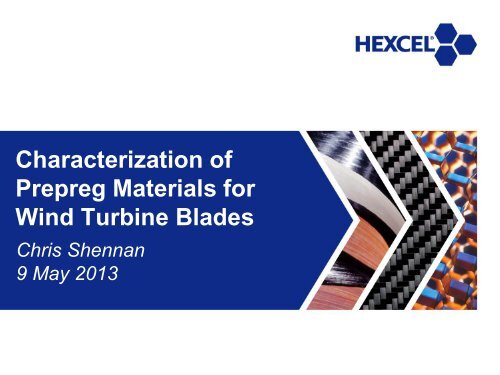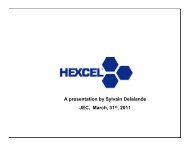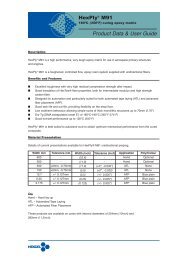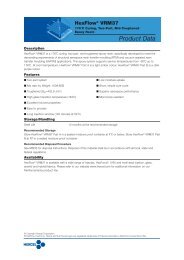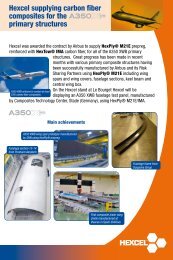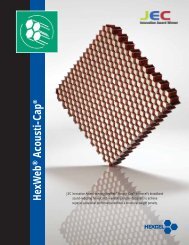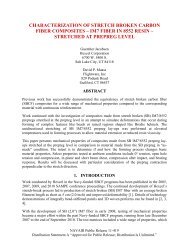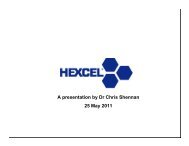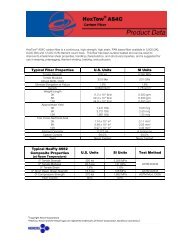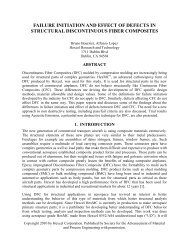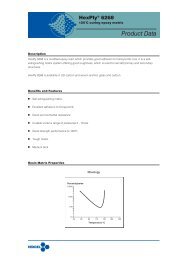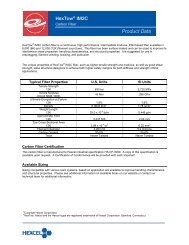Characterization of Prepreg Materials for Wind Turbine ... - Hexcel.com
Characterization of Prepreg Materials for Wind Turbine ... - Hexcel.com
Characterization of Prepreg Materials for Wind Turbine ... - Hexcel.com
You also want an ePaper? Increase the reach of your titles
YUMPU automatically turns print PDFs into web optimized ePapers that Google loves.
<strong>Characterization</strong> <strong>of</strong><br />
<strong>Prepreg</strong> <strong>Materials</strong> <strong>for</strong><br />
<strong>Wind</strong> <strong>Turbine</strong> Blades<br />
Chris Shennan<br />
9 May 2013
Agenda<br />
‣ <strong>Hexcel</strong> <strong>com</strong>pany pr<strong>of</strong>ile<br />
‣ Background to prepregs in wind energy<br />
‣ <strong>Prepreg</strong> characterisation<br />
• Surface prepregs (XF2P)<br />
• Structural prepregs (matrix system, M79)<br />
‣ Combinations <strong>of</strong> prepregs with infusion: co-infusion<br />
‣ Conclusions<br />
1<br />
©2013 <strong>Hexcel</strong>
Company Pr<strong>of</strong>ile<br />
‣ Technology leader in advanced <strong>com</strong>posites<br />
‣ Serving <strong>com</strong>mercial aerospace, space & defense and industrial<br />
‣ Net Sales 2012: $1.58 Billion<br />
‣ 5,000 employees worldwide<br />
‣ 19 manufacturing sites (including JV in Malaysia)<br />
‣ Headquarters in Stam<strong>for</strong>d, CT, USA<br />
‣ Listed on New York and Paris Stock Exchanges<br />
2<br />
©2013 <strong>Hexcel</strong>
Background<br />
<strong>Prepreg</strong>s in <strong>Wind</strong> Energy
Typical <strong>Prepreg</strong> Systems in <strong>Wind</strong> Energy<br />
Typical resin systems<br />
M9G<br />
310 J/g<br />
M9GF<br />
M19G<br />
UD Products<br />
230 J/g<br />
160 J/g<br />
Cure temperature ~100-120°C<br />
Carbon 500-600 g/m 2<br />
Glass 1000-3000 g/m 2<br />
Overall cure cycles<br />
~4 to ~8 hours (optimisation is key)<br />
Typical prepregs<br />
high areal weight + moderate cure temperature + low<br />
reaction enthalpy<br />
4<br />
©2013 <strong>Hexcel</strong>
The Value <strong>of</strong> Low Exotherm in Thick Laminates<br />
Temperature<br />
Faster ramp<br />
rate<br />
Higher dwell<br />
temperature <strong>for</strong><br />
shorter time<br />
Net reduction<br />
in cure cycle<br />
Time<br />
Low exotherm matrix e.g. M19G<br />
Standard exotherm matrix e.g. M9G<br />
5<br />
©2013 <strong>Hexcel</strong>
Features <strong>of</strong> Typical <strong>Wind</strong> <strong>Turbine</strong> Blades<br />
Surface<br />
Structure:<br />
Spar cap<br />
Shear web<br />
Shell<br />
Root end<br />
Process<br />
6<br />
©2013 <strong>Hexcel</strong>
<strong>Prepreg</strong> Characterisation<br />
This presentation will focus on the following<br />
Surface and shell prepreg<br />
‣ Characterisation <strong>of</strong> a surface prepreg that obviates an<br />
additional gel coat<br />
Structural prepreg <strong>for</strong> large/ thick sections<br />
‣ Characterisation <strong>of</strong> a new structural prepreg system, M79,<br />
that <strong>com</strong>bines:<br />
• Low temperature cure<br />
• Low exotherm<br />
7<br />
©2013 <strong>Hexcel</strong>
Characterisation <strong>of</strong> a<br />
Shell <strong>Prepreg</strong>:<br />
HexPly XF2P
<strong>Prepreg</strong>s <strong>for</strong> the Shell Surface<br />
Shell prepregs are used <strong>for</strong> the aerodynamic shell<br />
• Gel coats may be used to provide a good paint-ready surface<br />
• Polyurethane paints may be used <strong>for</strong> the final surface<br />
Painting makes the gel coat redundant as a surface finish<br />
system<br />
This process can be simplified by using specific shell<br />
prepregs such as HexPly XF2P<br />
• To build the aerodynamic shell surface<br />
• To eliminate the gel coat<br />
9<br />
©2013 <strong>Hexcel</strong>
Conventional Shell Construction, with Gel Coat<br />
<strong>Prepreg</strong><br />
Blade Mould<br />
Gel Coat<br />
10<br />
©2013 <strong>Hexcel</strong>
XF2P – Gel Coat-free Surface Finish<br />
No gel coat needed<br />
HexPly M9.6/ 43%/ LBB1200 + CV/ G<br />
<strong>Prepreg</strong><br />
Blade Mould<br />
XF2P layer<br />
11<br />
©2013 <strong>Hexcel</strong>
XF2P: Surface Characterisation<br />
Laminate surface from standard prepreg<br />
Laminate surface from XF2P<br />
Pinholes<br />
Surface must be repaired<br />
or gel coat must be used<br />
No pinholes<br />
Ready <strong>for</strong> painting*<br />
* After removal <strong>of</strong> release agent<br />
12<br />
©2013 <strong>Hexcel</strong>
Surface Porosity from Shell <strong>Materials</strong><br />
13<br />
©2013 <strong>Hexcel</strong>
XF2P: Cross-sectional Analysis<br />
Standard triax laminate<br />
surface layer defects<br />
Laminate using XF2P at surface<br />
1mm<br />
1mm<br />
14<br />
©2013 <strong>Hexcel</strong>
Characterisation <strong>of</strong><br />
<strong>Prepreg</strong> Matrices: M79<br />
Designed <strong>for</strong> Structural Applications
M79<br />
New generation prepreg system <strong>for</strong> large industrial structures<br />
(e.g. wind turbine blades)<br />
• Cure: 70°C ~10 hrs; 80°C ~6 hrs; 120°C 2 months<br />
• Exotherm ~100-120 j/g<br />
• Static mechanical properties as current M9G family prepregs<br />
• Product <strong>for</strong>m as current prepregs/ semipregs<br />
• Manufacture: standard process, as current M9G family prepregs<br />
16<br />
©2013 <strong>Hexcel</strong>
M79 Compared with Conventional Systems<br />
M9 family<br />
17<br />
©2013 <strong>Hexcel</strong>
Reduction in <strong>Prepreg</strong> Exotherm, 1995-2013<br />
Current standard<br />
prepreg matrices<br />
M79<br />
Latest prepreg matrices minimise reaction exotherm<br />
allowing short cure cycles <strong>of</strong> thick structures<br />
18<br />
©2013 <strong>Hexcel</strong>
M79: Example <strong>of</strong> Mechanical Test Data<br />
Test &<br />
Direction<br />
Tensile 0°<br />
Compression<br />
0°<br />
ILSS (45°,<br />
4-ply)<br />
Measurement<br />
Strength (MPa)<br />
Modulus (GPa)<br />
Strength (MPa)<br />
Modulus (GPa)<br />
Strength (MPa)<br />
No. <strong>of</strong><br />
specimens<br />
8<br />
10<br />
70 °C Cure<br />
Mean SD CV (%)<br />
M9<br />
Historical<br />
469 9.4 2.0 445<br />
21.2 0.5 2.5 18.2<br />
413 20 4.9 333<br />
21.0 0.3 1.4 19.5<br />
20 46.7 1.9 4.0 43.6<br />
Normalized results are in bold<br />
Test results <strong>for</strong> HexPly M79/43%/LBB1200+CV/G cured at 70 ºC<br />
Overall, M79 mechanical test data <strong>com</strong>pares favourably<br />
with conventional (M9) systems<br />
19<br />
©2013 <strong>Hexcel</strong>
M79: Example <strong>of</strong> Mechanical Test Data<br />
Test &<br />
Direction<br />
Tensile 0°<br />
Compression<br />
0°<br />
ILSS (45°, 4-<br />
ply)<br />
Measurement<br />
Strength (MPa)<br />
Modulus (GPa)<br />
Strength (MPa)<br />
Modulus (GPa)<br />
Strength (MPa)<br />
No. <strong>of</strong><br />
specimens<br />
20<br />
10<br />
80 °C Cure<br />
Mean SD CV (%)<br />
M9<br />
Historical<br />
456 16 3.6 445<br />
19.1 0.3 1.7 18.2<br />
394 30 7.5 333<br />
20.5 1.0 4.7 19.5<br />
20 39.5 1.1 2.7 43.6<br />
Normalized results are in bold<br />
Test results <strong>for</strong> HexPly M79/43%/LBB1200+CV/G cured at 80 o C<br />
Overall, M79 mechanical test data <strong>com</strong>pares favourably<br />
with conventional (M9) systems<br />
20<br />
©2013 <strong>Hexcel</strong>
M79 and Co-infusion<br />
Co-infusion<br />
The use <strong>of</strong> prepreg and infusion technologies in the same laminate<br />
with co-cure<br />
Typical configuration<br />
UD prepreg <strong>for</strong> the heavy load-carrying structure<br />
Infusion <strong>of</strong> dry rein<strong>for</strong>cement <strong>for</strong> the remainder <strong>of</strong> the structure<br />
Cure <strong>of</strong> the whole assembly at the same time and temperature<br />
M79 simplifies co-infusion when making large structures<br />
because it cures at 70-80°C (i.e. same temperature <strong>for</strong> both<br />
infusion and prepreg matrices)<br />
21<br />
©2013 <strong>Hexcel</strong>
<strong>Wind</strong> Blades: M79 co-cured in an Infused Shell<br />
<strong>Prepreg</strong> spar cap laid up on dry rein<strong>for</strong>cements<br />
Dry rein<strong>for</strong>cement co-infused with prepreg<br />
followed by co-cure<br />
22<br />
©2013 <strong>Hexcel</strong>
Co-infusion: Case Study after Demoulding<br />
The finished 4x2m laminate<br />
Low porosity, high Tg<br />
FV (%) 50<br />
Porosity (%)<br />
Tg (°C)<br />
Side 0,7<br />
Middle 1,5<br />
Top 75<br />
Middle 120<br />
Bottom 75<br />
Cure cycle 6hrs 90°C<br />
Co-infusion simplifies the production process, <strong>com</strong>bining<br />
the strengths <strong>of</strong> prepreg and infusion materials<br />
23<br />
©2013 <strong>Hexcel</strong>
Conclusions<br />
‣ <strong>Prepreg</strong>s are used <strong>for</strong> both structural and surface<br />
applications in wind blade construction<br />
‣ The surface <strong>of</strong> XF2P laminates have been characterised <strong>for</strong><br />
surface defects<br />
• Defects can be reduced by >99% to give a paint ready surface<br />
‣ M79, a new matrix <strong>for</strong> wind blades, has been characterised<br />
after cure at 70° and 80°C<br />
• Cure reaction enthalpies are 100-120 j/g, reducing from 350 j/g over the<br />
last 15 years<br />
• Static mechanical properties <strong>com</strong>pare favourably with standard materials<br />
‣ The low cure temperature <strong>of</strong> M79 helps enable co-infusion<br />
<strong>of</strong> prepreg with dry rein<strong>for</strong>cements, thus <strong>com</strong>bining the<br />
best features <strong>of</strong> each process<br />
24<br />
©2013 <strong>Hexcel</strong>
Disclaimer<br />
This document and all in<strong>for</strong>mation contained herein is the sole property <strong>of</strong><br />
HEXCEL CORPORATION. No intellectual property rights are granted by the<br />
delivery <strong>of</strong> this document or the disclosure <strong>of</strong> its content.<br />
This document shall not be reproduced or disclosed to a third party without the<br />
express written consent <strong>of</strong> HEXCEL. This document and its content shall not be<br />
used <strong>for</strong> any purpose other than that <strong>for</strong> which it is supplied.<br />
The statements made herein do not constitute an <strong>of</strong>fer. They are based on the<br />
mentioned assumptions and are expressed in good faith. Where the supporting<br />
grounds <strong>for</strong> these statements are not shown, HEXCEL will be pleased to explain<br />
the basis there<strong>of</strong>.<br />
25<br />
©2013 <strong>Hexcel</strong>


